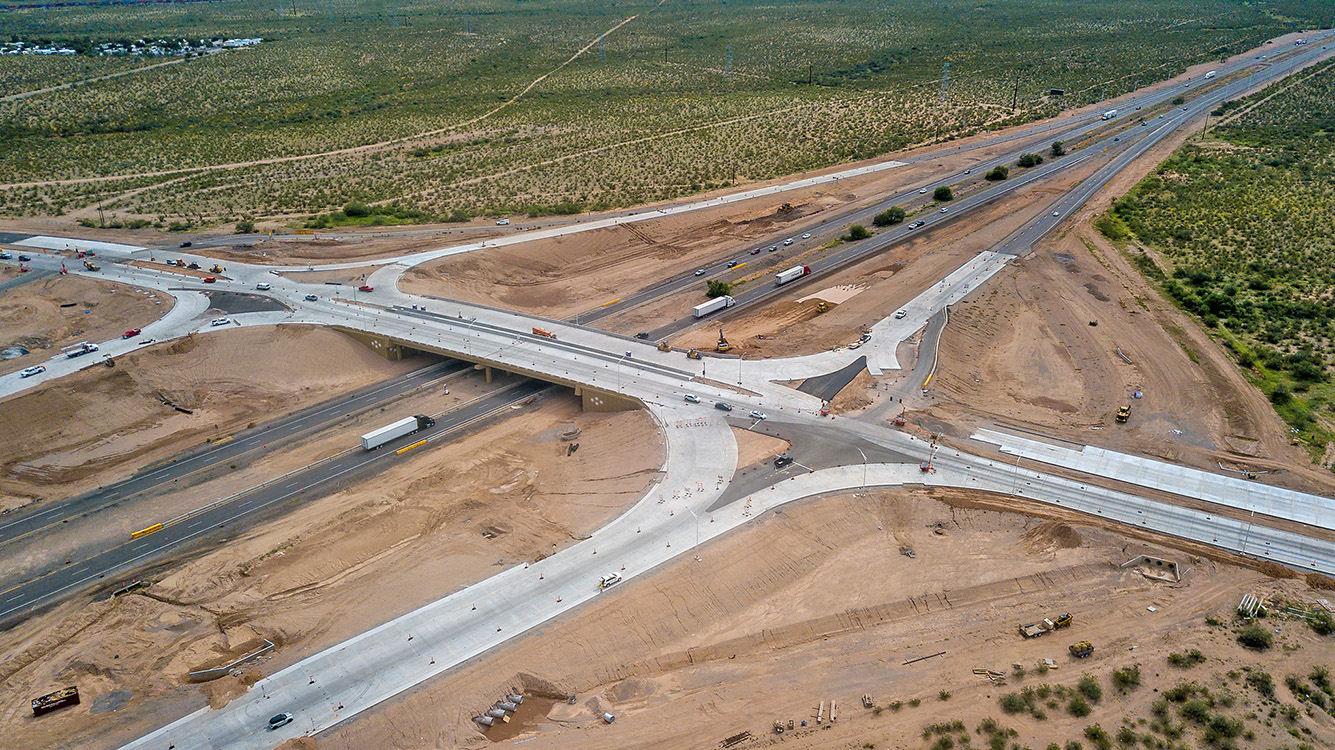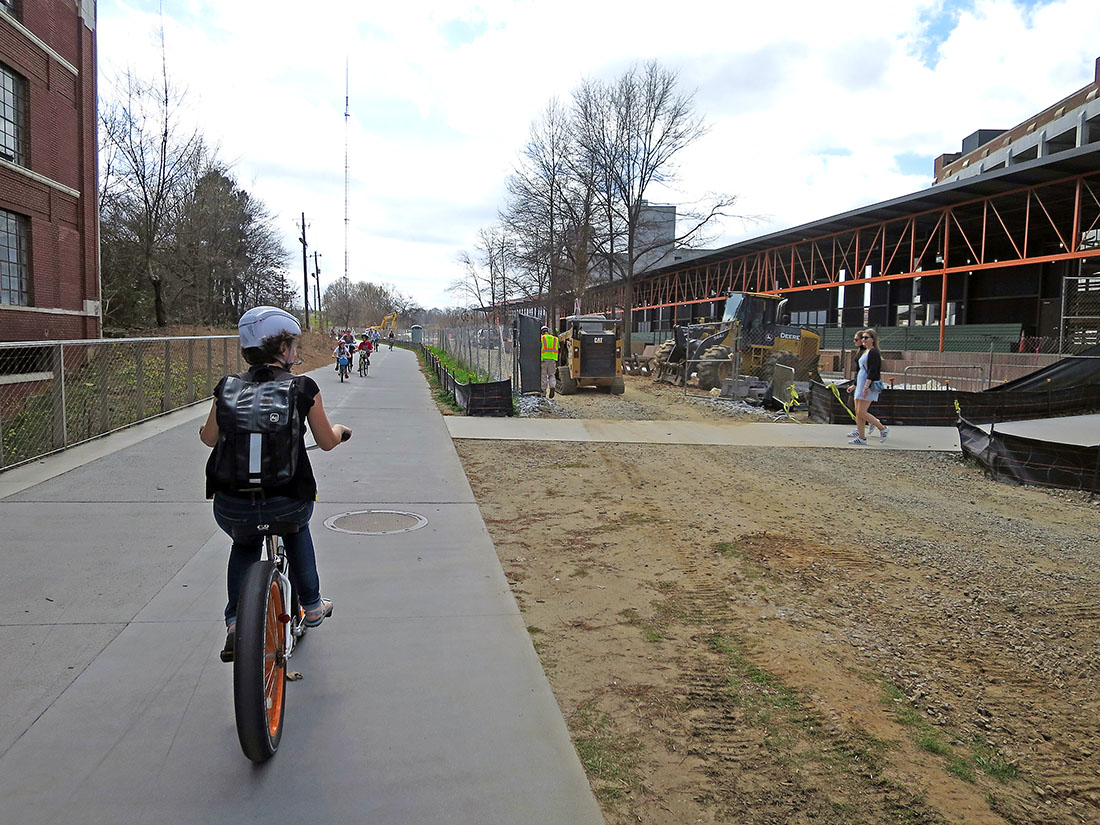
States Innovate!
Arizona Adds a New Diverging Diamond Interchange
The Arizona Department of Transportation’s (ADOT) Interstate 10/Houghton Road project features a diverging diamond interchange. According to an ADOT news release, ADOT traffic engineers chose the diverging diamond design because it can improve safety and handle higher traffic volumes in a growing part of the southeast Tucson area where traffic is expected to increase by as much as 50 percent by 2045. ADOT reported that more than 115 diverging diamond interchanges are in use in the United States, including two half-diverging diamond interchanges in the northern part of Arizona.

The Arizona DOT converted an interchange to a diverging diamond as part of its I-10/Houghton Road project to improve traffic operations.
Credit: Arizona Department of TransportationConcrete Overlay Gives Delaware Motorists a Smooth Ride for 20+ Years
In 1990, the Delaware Department of Transportation (DelDOT) initiated a comprehensive study to evaluate rehabilitation strategies for a 9-mile-long section of I-495 and the associated ramps around Wilmington. Major concerns about the existing concrete pavement included cracking and joint deterioration. After a review of several rehabilitation strategies, DelDOT selected an unbonded jointed plain concrete (UJPC) overlay with a 15-foot transverse joint spacing. A UJPC overlay allowed the use of the existing pavement structure, retained the affected concrete at the project site, and reduced construction time considerably, resulting in less disruption to traffic. After more than 26 years in service, DelDOT reports that the UJPC overlay on I-495 is performing well and continues to provide improved rideability and safety for road users. The project has required only minor maintenance activities such as joint spall repair, crack and joint sealing, and shoulder patching. Learn more in the EDC Targeted Overlay Pavement Solutions case study on the Delaware I-495 project.
Florida Benefits from Highly Modified Asphalt Overlays
The Florida Department of Transportation (FDOT) began using Highly Modified Asphalt (HiMA) 6 years ago to address severe rutting observed in high-stress locations that were subject to heavy axle loads and slow-moving traffic, such as truck weigh stations, agricultural inspection stations, and high-volume intersections and interchanges. Since then, the agency has placed more than 500,000 tons of HiMA mixtures on at least 40 projects across the State. In addition, FDOT expanded use of HiMA to other types of applications such as mitigating reflective cracking from construction joints in overlayed portland cement concrete pavements and reducing raveling in open-graded friction courses. FDOT research and preliminary data suggest the expected gain in pavement life will exceed what is needed to offset the additional cost of HiMA. Read about more Florida’s use of Targeted Overlay Pavement Solutions (TOPS) in the TOPS ebulletin.

PennDOT partnered with the developers of the Future Road Builders app to help spread its availability.
Credit: Constructors Association of Western PennsylvaniaGaming App Helps Users Explore Construction Project Skills
Stakeholders in Pennsylvania organized a working group to develop creative ways to market the highway construction industry to potential job candidates. One key way is redefining how people think about the necessity of a four-year degree. The working group is promoting construction apprenticeships as “the other four-year degree.” One member of the working group, the Constructors Association of Western Pennsylvania (CAWP), developed an app called Future Road Builders that lets users explore a virtual highway construction project to see the skills needed for the job. The Pennsylvania Department of Transportation (PennDOT) partnered with CAWP in 2016 to continue the development of the Future Road Builders platform to include an application for smart phones and tablets. Read more on PennDOT’s on-the-job training program webpage.
Puerto Rico Employs Project Bundling
The Puerto Rico Highway and Transportation Authority (PRHTA) is designing highway construction projects to correct landslides and replace traffic signs and guardrails affected by Hurricanes Irma and Maria using Federal funds from the FHWA Emergency Relief Program. To facilitate the bidding process for more than 500 locations, PRHTA requested assistance from FHWA’s Eastern Federal Lands Highway Division (EFLHD) in the project management process. EFLHD is using project bundling to award a single contract for several similar projects. The project bundling approach streamlines design, contracting, and construction and allows agencies to capitalize on economies of scale to increase efficiency. EFHLD began the procurement process of several projects with the project bundling technique in late 2020. Read more in Puerto Rico’s State Transportation Innovation Council newsletter.

The Atlanta BeltLine project highlights the use of value capture tools on a multimodal project that includes roadway improvements, bike lanes, pedestrian paths, and transit.
Credit: Danquella ManeraValue Capture Helps Fund Development in Metro Atlanta
In Georgia, the Atlanta BeltLine is transforming a 22-mile corridor of unused railroad segments into a multi-modal urban redevelopment around downtown Atlanta. The development includes multi-purpose trails, bike paths, and a modern streetcar. The vision for the BeltLine is to knit 45 Atlanta neighborhoods together through a green amenity while stimulating economic development. The BeltLine has attracted philanthropic and corporate dollars, and leveraged Federal and State funds, but its main source of financing is a value-capture mechanism that directs increased property-tax revenues from new development and economic growth above an initial baseline into a special-purpose tax allocation district (TAD) fund that repays project-related debt. Atlanta BeltLine, Inc., the quasi-public corporation created to administer the BeltLine, has issued $155 million in TAD bonds so far.
Notice: The U.S. Government does not endorse products or manufacturers. Trademarks or manufacturers’ names appear in this article only because they are considered essential to the objective of the document.
Recommended Citation: U.S. Department of Transportation, Federal Highway Administration - Washington, DC (2022) Innovator Newsletter, March/April 2022, Volume 15 (89). https://doi.org/10.21949/1521807



